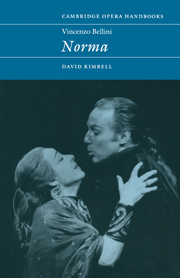Book contents
- Frontmatter
- Contents
- List of plates
- General preface
- Dedication
- Preface
- A note on Italian prosody
- A note on the vocal score
- 1 The composition of the opera
- 2 Medea – Velleda – Norma: Romani's sources
- 3 Synopsis and musical frame
- 4 Music and poetry
- 5 A glimpse of the genesis of the opera
- 6 Some variant readings
- 7 Contemporary reactions to Norma
- 8 Critical fortunes since the Unification of Italy
- 9 Five prima donnas: contributions to a performance history
- Appendices
- Notes
- Bibliography
- Index
6 - Some variant readings
Published online by Cambridge University Press: 05 June 2012
- Frontmatter
- Contents
- List of plates
- General preface
- Dedication
- Preface
- A note on Italian prosody
- A note on the vocal score
- 1 The composition of the opera
- 2 Medea – Velleda – Norma: Romani's sources
- 3 Synopsis and musical frame
- 4 Music and poetry
- 5 A glimpse of the genesis of the opera
- 6 Some variant readings
- 7 Contemporary reactions to Norma
- 8 Critical fortunes since the Unification of Italy
- 9 Five prima donnas: contributions to a performance history
- Appendices
- Notes
- Bibliography
- Index
Summary
An equal but different interest attaches to the variant readings in the first printed edition of Norma, a vocal score issued in the spring of 1832: NORMA / Tragedia liricadi F. Romani / posta in musicae dedicata / Al Signor / N. ZINGARELLI / dal suo allievo / V. BELLINI / Riduzione per Canto con acc.to di P. F. … NAPOLI – MILANO / TITO DI GIOVANNI RICORDI (plate nos. 3723–3736).
There can be no doubt that, except for the few minor errors it contains – missing accidentals etc. – this was the form in which, at the time, Bellini expected and wished for his opera to appear. Yet in several movements it differs fundamentally from the modern vocal score (plate no. 41684), the readings of which go back to Ricordi's second edition of Norma, ‘corrected in accordance with the last modifications carried out by the author’ (plate nos. 30981–30995) (Brauner 1976,p. 108). The purpose of the present chapter is to scrutinize those changes that affect the structure of the opera, and to argue that, in general, the original versions are superior.
No.5 Finale (Act I)
(a) Scenae Duetto (Norma, Adalgisa)
The original vocal score (plate no. 3729) published the cabaletta in a different form: between Norma's solo verse and what does service for the duet verse.Adalgisa too had a solo verse, essentially identical with Norma's solo, except for the text. There followed an entirely conventional linking passage: a bar of overlapping dialogue (performed three times), and two bars of cadenza a due, leading into the duet verse.
Information
- Type
- Chapter
- Information
- Vincenzo Bellini: Norma , pp. 83 - 88Publisher: Cambridge University PressPrint publication year: 1998
